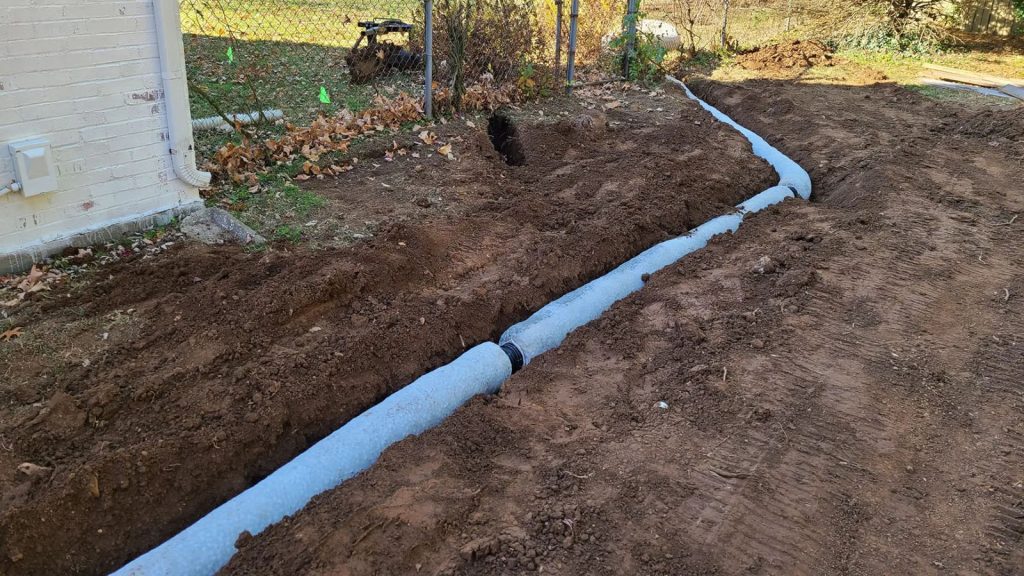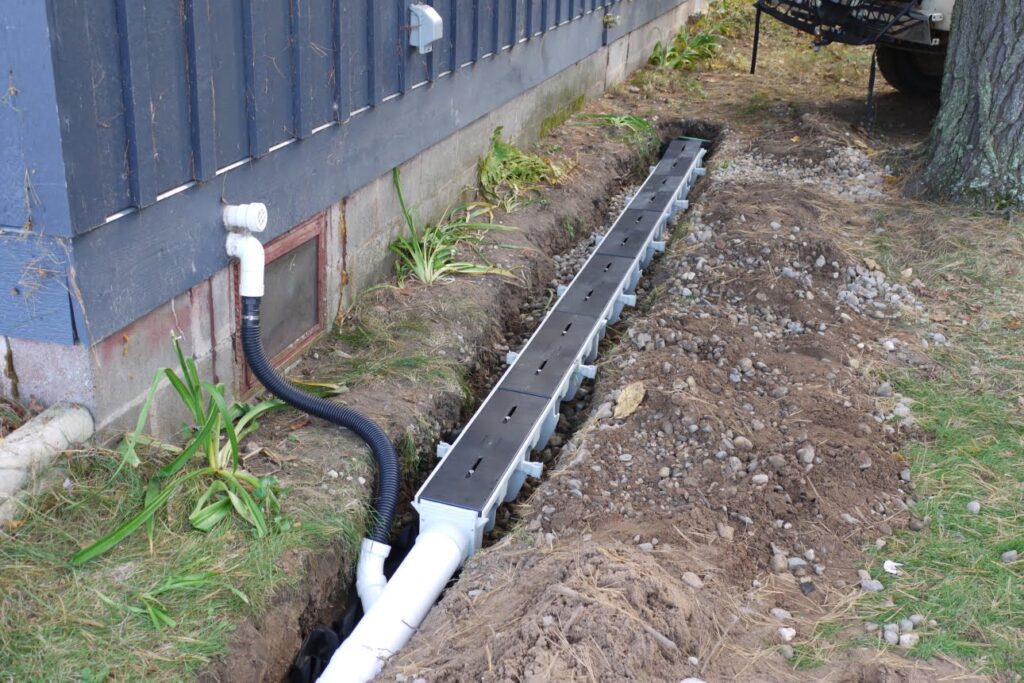What is French Drain System? Discover the #1 Drainage Fix
Dealing with excess water around your property? A French drain system could be the solution you need.
It directs water away from your home, preventing damage to your yard or basement.
In this guide, we’ll explain how a French drain works, what benefits it offers, and how it can improve your property’s drainage system.
What is a French drain system?
A French drain system is a trench filled with gravel that channels water away from an area. It’s ideal for preventing water accumulation in basements, yards, or anywhere flooding is a concern.
Key Takeaways
- A French drain system is designed to redirect water away from areas where it can cause problems, like your home’s foundation or your yard.
- French drains are typically made of perforated pipe, gravel, and fabric to allow for effective water flow and filtration.
- Installing a French drain can improve the health of your garden, prevent basement flooding, and protect your property from water damage.
What is a French Drain System?

A French drain system is an effective and reliable solution to manage excess water around your property.
When it comes to managing excess water around your property, a French drain system can be a highly effective solution.
Whether you’re dealing with a soggy garden, a wet basement, or standing water in your yard, a French drain can help direct water away from your home, preventing damage and improving the overall drainage of your land.
We’ll explain what a French drain system is, how it works, and the key benefits it offers to homeowners dealing with drainage issues.
Its primary purpose is to redirect water from areas where it might accumulate, such as basements, gardens, or around foundations, to a safer location where it can be drained away efficiently.
By doing so, it helps prevent water damage, flooding, and erosion, which can lead to costly repairs and deterioration of your property.
Basic Components of a French Drain
A typical French drain system consists of a trench, gravel, and a perforated drainage pipe.
Each component works together to provide an efficient drainage solution that keeps excess water away from vulnerable areas of your property.
The Trench: The foundation of any French drain system is the trench. The trench is typically dug at a slope so that gravity helps guide the water toward the intended drainage location.
The depth and width of the trench depend on the size of the area you are trying to drain, but typically it is between 6 inches and 24 inches wide and 18 inches to 36 inches deep.
Gravel: Once the trench is dug, it is filled with gravel, which acts as a filtering medium.
The gravel helps separate the water from any soil or debris, allowing the water to flow freely through the pipe without clogging.
Gravel also provides an easy path for the water to flow through and away from the area of concern.
Perforated Pipe: The most crucial element of a French drain system is the perforated pipe that lies at the bottom of the gravel-filled trench.
The pipe has small holes or slits that allow water to enter, flow through, and be redirected to a safe drainage area.
The water is filtered as it passes through the gravel, leaving behind any dirt or debris before being funneled away.
How Does a French Drain Work?

The working principle behind a French drain is simple but highly effective. It utilizes gravity to move water away from areas where it’s unwanted.
The trench is angled to allow water to flow toward the perforated pipe, which collects the water and carries it away.
Once the water flows through the pipe, it exits the system at a designated drainage point usually a storm drain, dry well, or natural drainage area.
The gravel surrounding the pipe serves multiple purposes.
It prevents dirt and debris from entering the pipe and clogging it, and it helps distribute the water evenly, ensuring the system doesn’t become overwhelmed.
The water flows through the gravel, enters the pipe, and is carried away to a lower point, preventing any buildup in the area being drained.
A French drain system is an efficient, long-lasting, and cost-effective way to manage excess water around your property.
By redirecting water from areas where it may cause damage, such as near foundations or in gardens, a French drain helps protect your home and landscape from water damage, erosion, and flooding.
If you’re dealing with a water drainage issue, installing a French drain is a smart investment that can provide lasting protection for your property.
Types of French Drains

While the basic concept of a French drain is fairly standard, there are a few different types, depending on the specific needs of your property.
Let’s look at the most common types of French drains:
1. Traditional French Drain
The traditional French drain consists of a trench, gravel, and a perforated pipe.
It is the most widely used type of French drain, providing effective water diversion for many different types of properties.
2. Surface Drain (Shallow French Drain)
Surface drains, also called shallow French drains, are typically used to address drainage issues that don’t require deep trenching.
They are ideal for areas where water pools on the surface, such as around gardens, patios, or walkways.
3. Dry Well Drain
A dry well is an extension of a French drain system designed to capture water and allow it to dissipate slowly into the ground.
It is often used in areas where there isn’t an immediate outlet for the water, such as in rural or suburban areas without storm drains.
Benefits of Installing a French Drain System

French drains offer several significant advantages, particularly for homeowners dealing with water drainage issues. Here are some of the key benefits:
1. Prevents Water Damage to Your Property
By diverting water away from your home’s foundation, a French drain system helps prevent flooding in your basement or crawlspace.
It also helps protect your landscaping and driveway from water damage and erosion.
2. Improves Yard Health
Excess water in your yard can lead to puddles, soggy soil, and poor plant health.
A French drain system helps regulate the water levels in your yard, ensuring that your plants, flowers, and grass thrive without being overwatered.
3. Reduces the Risk of Mold and Mildew
Excess moisture around your home can create ideal conditions for mould and mildew to grow.
By removing water from around your foundation, a French drain reduces the risk of these drainage problems, which can affect both the structural integrity of your home and your indoor air quality.
4. Easy to Maintain
Once installed, French drains are relatively easy to maintain. With periodic cleaning of the pipe and gravel, the system can last for many years without needing significant repairs.
Maintenance typically involves removing debris that may clog the pipe or cause blockages.
5. Cost-Effective Solution
While the initial installation of a French drain can involve a bit of a cost, it’s often more affordable than other drainage solutions.
Furthermore, it’s a long-term investment that can save you money on repairs caused by water damage.
When to Install a French Drain
A French drain is an excellent choice if you’re dealing with any of the following problems:
Flooded Basement: If water tends to collect around the foundation and leaks into your basement, a French drain can help divert the water away, reducing the risk of basement flooding.
Poor Yard Drainage: If you have standing water in your yard, a French drain can help redirect the water to areas where it won’t cause damage.
Erosion Issues: In areas where water runoff is eroding your soil, a French drain can help prevent further damage and protect your landscaping.
How to Install a French Drain

Installing a French drain is a relatively straightforward process, but it does require some basic knowledge of digging and plumbing.
If you’re comfortable with DIY projects, you can tackle this job yourself, but if not, it’s best to hire a professional.
Here’s a basic outline of the installation process:
Mark the Drain Path: Decide where you want to install the French drain. It should slope away from your home to direct water to an appropriate drainage area.
Dig the Trench: Dig a trench that is about 6 inches to 12 inches deep and wide enough to accommodate the perforated pipe. The trench should slope downward to ensure water flows freely.
Add Gravel: Add a layer of gravel to the bottom of the trench to provide a stable base for the pipe and improve water flow.
Install the Perforated Pipe: Place the perforated pipe into the trench, making sure the holes are facing down so water can enter the pipe.
Cover with Gravel: Once the pipe is in place, cover it with more gravel. You can also add a layer of landscape fabric to prevent dirt and debris from clogging the system.
Fill the Trench: Fill the trench with soil or sod, leaving the top of the drain system slightly below ground level to prevent water from collecting on top.
Frequently Asked Questions
1. How deep does a French drain need to be?
A French drain typically needs to be between 6 inches to 12 inches deep, depending on the area you’re draining and the slope you need to achieve for proper water flow.
2. How long does it take to install a French drain?
The French drain installation time for a French drain can vary depending on the size of the area, but most DIY installations take between one to two days to complete.
3. Can I install a French drain myself?
Yes, installing a French drain is a manageable DIY project for most homeowners. However, if you’re dealing with complex drainage issues, it’s a good idea to consult with a professional.
Conclusion
A French drain is an effective solution for managing excess water around your property.
It’s a cost-effective, low-maintenance system that helps protect your home, garden, and driveway from water damage.
Whether you’re dealing with a soggy yard or flooding near your foundation, a French drain can provide the relief you need.
By following the proper installation steps or working with a professional, you can keep your property safe and dry for years to come.
